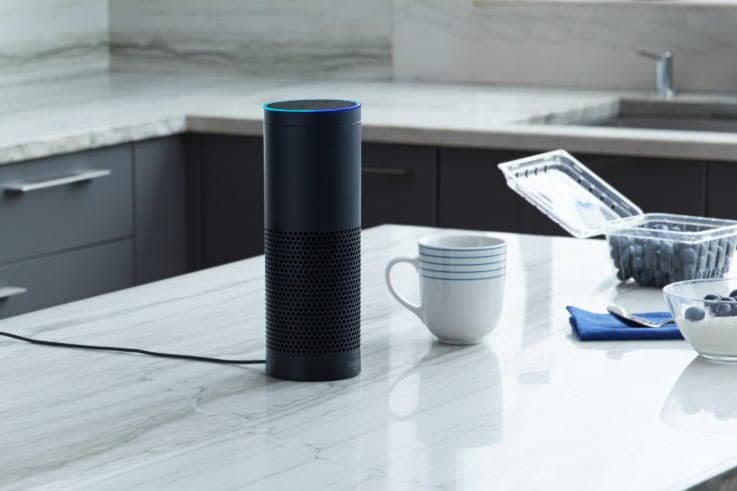Retail Trends Factfile 2017: Voice


Voice is growing. With digital assistants on our smartphones and voice-enabled devices like the Amazon Echo in our homes, voice is becoming increasingly important to retail. Check out these top voice facts to find out how.
Owners of the Amazon Echo spent around 10% more on Amazon in the six months after they bought the device than before they purchased it, with purchase frequency also going up by 6%. (Amazon, 2017)
More than 5 million Apple iPhone users in the US will use AirPods to communicate vocally with their mobile devices by the end of 2017. (Gartner, 2016)
Five percent of consumer-facing US websites will feature audio interfaces by the end of 2017. (Gartner, 2016)
One in five searches on US android mobile app are voice searches. (Google, 2016)
8.2 million U.S. shoppers own an Amazon Echo. That’s up 173% from an estimated 3 million shoppers in 2016. (CIRP, 2017)
82% of all Amazon shoppers in the US are familiar with the Echo, nearly double the 47% of shoppers who knew about the devices a year ago. (Amazon, 2017)
Google Trends imply queries associated with voice-related commands have risen 35x from 2008 to 2016 after launch of iPhone & Google Voice Search. (Google, 2016)
Google gets about 30 times more action queries by voice than by typing. (Google, 2016)
It is 3x faster to shop using microphone than to navigate menus in mobile apps. (MindMeld, 2016)
In 2015, there were 1.7 million voice-first devices shipped. In 2016, there were 6.5 million devices shipped. (VoiceBot.ai, 2017)
The number of Alexa voice skills has increased from 1000 in June 2016 to 7000 in January 2017. (Voice Labs, 2017)
2016 saw an incredible rise in connected home devices, specifically Amazon Echo (8 million devices sold) and Google Home devices. (Internet Retailer, 2017)
A survey of 228 Amazon customers found 17% use Alexa for ordering items from the e-commerce service. (RBC Capital Markets, 2017)
Voice-enabled speaker usage to grow nearly 130% this year in the US. (eMarketer, 2017)
Amazon controls 70% of the voice-enabled speaker device market in the US. (eMarketer, 2017)

Usage of voice-enabled speakers in the US will grow 23.1% in 2017. (eMarketer, 2017)
This year, 60.5 million Americans will use Siri, Cortana or another virtual assistant at least once a month. That equates to 27.5% of smartphone users, or nearly one-fifth of the population. (eMarketer, 2017)
Google reported that 20% of mobile searches by US Android device users were made by voice in 2016. (Google, 2017)
10% of millennials surveyed have already used voice-activated ordering, and 38% of millennials are willing to try it. (Accenture, 2017)
50% of iPhone users surveyed in the US use Siri. By comparison, only 22% of Windows phone users use Cortana. (Parks Associates, 2017)
Even now 45% of people surveyed in the UK only use voice “because it’s fun”. (JWT/Mindshare, 2017)
87% of regular UK voice users surveyed believe the technology simplifies their lives, but only when it works properly. (JWT/Mindshare, 2017)
37% of UK smartphone users surveyed use voice technology of some kind at least once a month and 18% use it at least weekly. (JWT/Mindshare, 2017)
Among early adopters of the Amazon Echo surveyed in the UK, 60% say “Alexa has become integral to my daily routine.” (JWT/Mindshare, 2017)
48% of non-voice users surveyed in the UK said they “don’t see the point.” (JWT/Mindshare, 2017)
Of regular Alexa users surveyed in the UK, 46% would like back-and-forth dialogue to get to better answers. (JWT/Mindshare, 2017)
Google voice search and Siri have the highest usage penetration, with 11% of UK smartphone users surveyed using them at least weekly. (JWT/Mindshare, 2017)

41% of all regular UK voice users surveyed said they use voice tech when they are feeling lazy. (JWT/Mindshare, 2017)
Around a third (32%) of UK smartphone users surveyed are excited about a future where “my voice assistant will anticipate what I need and take actions or make suggestions.” (JWT/Mindshare, 2017)
44% of UK smartphone users surveyed believe voice technology will help people interact more with each other. (JWT/Mindshare, 2017)
18% of regular voice users surveyed in the UK have bought a product using their vocal chords, without looking at the product online first. 24% of consumers have bought a product using their voice after seeing it elsewhere. (JWT/Mindshare, 2017)
50% of all searches will be conducted through voice by 2020. (Comscore, 2017)
About 30% of searches will be done without a screen by 2020. (Gartner, 2017)
There will be 21.4 million smart speakers in the US by 2020. (Activate, 2017)
By 2019, the voice recognition market will be a $601 million industry. (Technavio, 2017)
In 2017, 25 million devices will be shipped, bringing the total number of voice-first devices to 33 million in circulation. (VoiceLabs, 2017)
25% of 16-24s use voice search on mobile. (Global Web Index, 2017)
45% of those who have used AI personal assistants said they’ve used Siri. 33% have used Google Now. 27% used Microsoft’s Cortana. 10% have used Amazon Echo or Alexa. (AYTM, 2017)
One in five online adults have used voice search on their mobile in the last month. (Global Web Insights, 2017)
Mobile voice-related searches are 3X more likely to be local-based than text. (Search Engine Watch, 2017)
Nearly 50% of people are now using voice search when researching products. (Social Media Today 2017)
41% of US people surveyed using voice search have only started in the last 6 months. (MindMeld, 2016)



